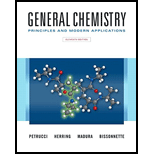
Concept explainers
(a)
Interpretation:
The Lewis structure of H2O needs to be determined.
Concept introduction:
Lewis structures are also known as Lewis dot structures or electron dot structures. These provide a simplified representation of the valence shell electrons in a molecule. The covalent bonding of a molecule or ion is represented using simple representation as dots. The sharing of electrons is done to get a stable octet structure. These shared electrons are represented as dots and this represents each atom to have eight electrons. The connectivity between the atoms within a molecule is easily represented via a Lewis structure. It is the valence electrons that are represented along with the lone pairs that can also be indicated and identified in the molecule structure.
(b)
Interpretation:
The Lewis structure of CH3NH2 needs to be drawn.
Concept introduction:
A Lewis dot structure is to represent valence shell electrons in a simplified manner. The dots represented here indicate the covalent bonds. These dots also indicate the electrons of individual atoms that are shared. These dots are mostly the valence electrons of the atom. It represents lone pairs as well. The dots between the two atoms represent the bond and dots present on the atom represent a lone pair of electrons.
(c)
Interpretation:
The Lewis structure of ONO- needs to be determined.
Concept introduction:
A Lewis dot structure is to represent valence shell electrons in a simplified manner. The dots represented here is to indicate the covalent bonds. The dots indicate the electrons of individual atoms that are shared. These dots are mostly the valence electrons of the atom. It represents lone pairs as well. The dots between the two atoms represent the bond and dots present on the atom represents a lone pair of electrons.
(d)
Interpretation:
The Lewis structure of SCN- needs to be determined.
Concept introduction:
A Lewis dot structure is to represent valence shell electrons in a simplified manner. The dots represented here is to indicate the covalent bonds. The dots indicate the electrons of individual atoms that are shared. These dots are mostly the valence electrons of the atom. It represents lone pairs as well. The dots between the two atoms represent the bond and dots present on the atom represent a lone pair of electrons.
Want to see the full answer?
Check out a sample textbook solution
Chapter 24 Solutions
EBK GENERAL CHEMISTRY
- Calculate the pH and the pOH of each of the following solutions at 25 °C for which the substances ionize completely: (a) 0.000259 M HClO4arrow_forwardWhat is the pH of a 1.0 L buffer made with 0.300 mol of HF (Ka = 6.8 × 10⁻⁴) and 0.200 mol of NaF to which 0.160 mol of NaOH were added?arrow_forwardDetermine if the following salt is neutral, acidic or basic. If acidic or basic, write the appropriate equilibrium equation for the acid or base that exists when the salt is dissolved in aqueous solution. If neutral, simply write only NR. Be sure to include the proper phases for all species within the reaction. NaN₃arrow_forward
- A. Draw the structure of each of the following alcohols. Then draw and name the product you would expect to produce by the oxidation of each. a. 4-Methyl-2-heptanol b. 3,4-Dimethyl-1-pentanol c. 4-Ethyl-2-heptanol d. 5,7-Dichloro-3-heptanolarrow_forwardWhat is the pH of a 1.0 L buffer made with 0.300 mol of HF (Ka = 6.8 × 10⁻⁴) and 0.200 mol of NaF to which 0.160 mol of NaOH were added?arrow_forwardCan I please get help with this.arrow_forward
- Determine if the following salt is neutral, acidic or basic. If acidic or basic, write the appropriate equilibrium equation for the acid or base that exists when the salt is dissolved in aqueous solution. If neutral, simply write only NR. Be sure to include the proper phases for all species within the reaction. N₂H₅ClO₄arrow_forwardPlease help me with identifying these.arrow_forwardCan I please get help with this?arrow_forward
 Chemistry: The Molecular ScienceChemistryISBN:9781285199047Author:John W. Moore, Conrad L. StanitskiPublisher:Cengage Learning
Chemistry: The Molecular ScienceChemistryISBN:9781285199047Author:John W. Moore, Conrad L. StanitskiPublisher:Cengage Learning Chemistry: Principles and ReactionsChemistryISBN:9781305079373Author:William L. Masterton, Cecile N. HurleyPublisher:Cengage Learning
Chemistry: Principles and ReactionsChemistryISBN:9781305079373Author:William L. Masterton, Cecile N. HurleyPublisher:Cengage Learning ChemistryChemistryISBN:9781305957404Author:Steven S. Zumdahl, Susan A. Zumdahl, Donald J. DeCostePublisher:Cengage Learning
ChemistryChemistryISBN:9781305957404Author:Steven S. Zumdahl, Susan A. Zumdahl, Donald J. DeCostePublisher:Cengage Learning Chemistry: An Atoms First ApproachChemistryISBN:9781305079243Author:Steven S. Zumdahl, Susan A. ZumdahlPublisher:Cengage Learning
Chemistry: An Atoms First ApproachChemistryISBN:9781305079243Author:Steven S. Zumdahl, Susan A. ZumdahlPublisher:Cengage Learning
 Chemistry & Chemical ReactivityChemistryISBN:9781337399074Author:John C. Kotz, Paul M. Treichel, John Townsend, David TreichelPublisher:Cengage Learning
Chemistry & Chemical ReactivityChemistryISBN:9781337399074Author:John C. Kotz, Paul M. Treichel, John Townsend, David TreichelPublisher:Cengage Learning





